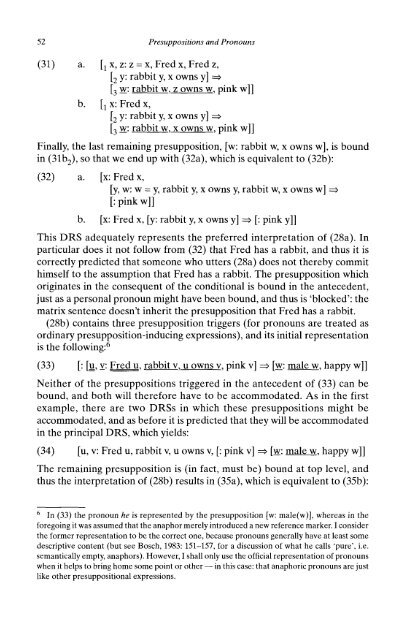Presuppositions and Pronouns - Nijmegen Centre for Semantics
Presuppositions and Pronouns - Nijmegen Centre for Semantics
Presuppositions and Pronouns - Nijmegen Centre for Semantics
You also want an ePaper? Increase the reach of your titles
YUMPU automatically turns print PDFs into web optimized ePapers that Google loves.
52 <strong>Presuppositions</strong> <strong>and</strong> <strong>Pronouns</strong><br />
(31) a. [ 1 b x, z: z = x, Fred x, Fred z,<br />
bY: [ 2 y: rabbit y, x owns y] ::::}<br />
[3[ 3 ~: w: rabbit w, z owns w, w. pink w]]<br />
b. [ 1 b x: Fred x,<br />
b [ 2 y: rabbit y, x owns y] => ::::}<br />
[3~: [ 3 w: rabbit w, w. x owns w, w. pink w]]<br />
Finally, the last remaining presupposition, [w: rabbit w, x owns w], is bound<br />
in (31b 2 ), so that we end up with (32a), which is equivalent to (32b):<br />
(32) a. [x: Fred x,<br />
[y, w: w = y, rabbit y, x owns y, rabbit w, x owns w] => ::::}<br />
[: pink w]]<br />
b. [x: Fred x, [y: rabbit y, x owns y] ::::} => [: pink y]]<br />
This DRS adequately represents the preferred interpretation of (28a). In<br />
particular does it not follow from (32) that Fred has a rabbit, <strong>and</strong> thus it is<br />
correctly predicted that someone who utters (28a) does not thereby commit<br />
himself to the assumption that Fred has a rabbit. The presupposition which<br />
originates in the consequent of the conditional is bound in the antecedent,<br />
just as a personal pronoun might have been bound, <strong>and</strong> thus is 'blocked': the<br />
matrix sentence doesn't inherit the presupposition that Fred has a rabbit.<br />
(28b) contains three presupposition triggers (<strong>for</strong> pronouns are treated as<br />
ordinary presupposition-inducing expressions), <strong>and</strong> its initial representation<br />
is the following: 6<br />
(33) [: lli, [a, y: v: Fred u, rabbit v, v. u owns v, v. pink v] ::::} => [~: [w: male w, happy w]]<br />
Neither of the presuppositions triggered in the antecedent of (33) can be<br />
bound, <strong>and</strong> both will there<strong>for</strong>e have to be accommodated. As in the first<br />
example, there are two DRSs in which these presuppositions might be<br />
accommodated, <strong>and</strong> as be<strong>for</strong>e it is predicted that they will be accommodated<br />
in the principal DRS, which yields:<br />
(34) [u, v: Fred u, rabbit v, u owns v, [: pink v] ::::} => [~: [w: male w, happy w]]<br />
The remaining presupposition is (in fact, must be) bound at top level, <strong>and</strong><br />
thus the interpretation of (28b) results in (35a), which is equivalent to (35b):<br />
6<br />
6 In (33) the pronoun he is represented by the presupposition [w: male(w)], whereas in the<br />
<strong>for</strong>egoing it was assumed that the anaphor merely introduced a new reference marker. I consider<br />
the <strong>for</strong>mer representation to be the correct one, because pronouns generally have at least some<br />
descriptive content (but see Bosch, 1983: 151-157, <strong>for</strong> a discussion of what he calls 'pure', i.e.<br />
semantically empty, anaphors). However, I shall only use the official representation of pronouns<br />
when it helps to bring home some point or other -— in this case: that anaphoric pronouns are just<br />
like other presuppositional expressions.














